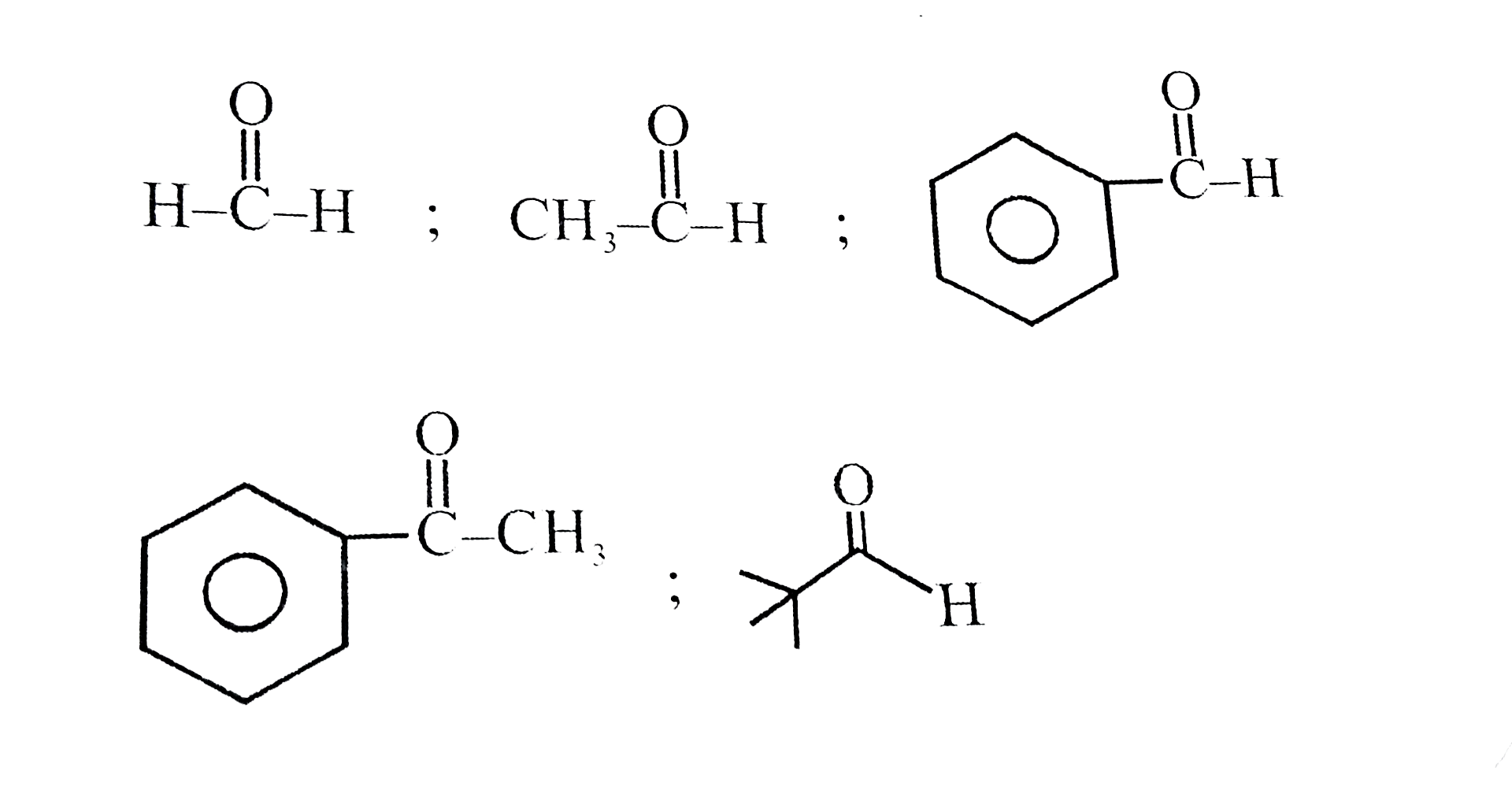Describe the following
i. Acetylation
ii. Cannizzaro reaction
iii. Cross aldol condensation
iv. Decarboxylation
Step-by-Step Text Solution
i. Acetylation
Acetylation is a chemical reaction that introduces an acetyl group (−COCH₃) into a molecule. This process typically involves the reaction of an organic compound with acetyl chloride (or acetic anhydride) in the presence of a Lewis acid catalyst, such as aluminum chloride (AlCl₃).
Example:
When benzene reacts with acetyl chloride in the presence of AlCl₃, it undergoes electrophilic substitution to form acetophenone (C₆H₅COCH₃) and hydrochloric acid (HCl) as a byproduct.
Reaction:
C6H6+CH3COClAlCl3−−−→C6H5COCH3+HCl
---
ii. Cannizzaro Reaction
The Cannizzaro reaction is a redox reaction that occurs in aldehydes lacking alpha-hydrogens. In this reaction, two moles of the aldehyde react in the presence of a strong base (like sodium hydroxide) to produce one mole of alcohol and one mole of the corresponding carboxylic acid salt.
Example:
For benzaldehyde (C₆H₅CHO), when it reacts with sodium hydroxide, it undergoes disproportionation to yield benzyl alcohol (C₆H₅CH₂OH) and sodium benzoate (C₆H₅COONa).
Reaction:
2C6H5CHO+NaOH→C6H5CH2OH+C6H5COONa
---
iii. Cross Aldol Condensation
Cross aldol condensation involves the reaction of two different aldehydes or ketones that each contain at least one alpha-hydrogen. In this reaction, the carbonyl compounds undergo a nucleophilic addition followed by dehydration to form α,β-unsaturated carbonyl compounds.
Example:
When acetaldehyde (CH₃CHO) reacts with propanal (C₂H₅CHO) in the presence of a base (like sodium hydroxide), it leads to the formation of both aldol products and cross-aldol products.
Products:
- Aldol product from acetaldehyde: 3-hydroxybutanal (CH₃CH(OH)CH₂CHO)
- Aldol product from propanal: 4-hydroxy-4-methylpentan-2-one (C₃H₇C(OH)(C₃H₇)CHO)
---
iv. Decarboxylation
Decarboxylation is the process of removing a carboxyl group (−COOH) from a compound, resulting in the release of carbon dioxide (CO₂). This reaction is commonly carried out using soda lime (a mixture of sodium hydroxide and calcium oxide).
Example:
When sodium acetate (CH₃COONa) is heated with soda lime, it undergoes decarboxylation to produce methane (CH₄) and sodium carbonate (Na₂CO₃).
Reaction:
CH3COONa+soda lime→CH4+Na2CO3
---
Acetylation is a chemical reaction that introduces an acetyl group (−COCH₃) into a molecule. This process typically involves the reaction of an organic compound with acetyl chloride (or acetic anhydride) in the presence of a Lewis acid catalyst, such as aluminum chloride (AlCl₃).
When benzene reacts with acetyl chloride in the presence of AlCl₃, it undergoes electrophilic substitution to form acetophenone (C₆H₅COCH₃) and hydrochloric acid (HCl) as a byproduct.
C6H6+CH3COClAlCl3−−−→C6H5COCH3+HCl
The Cannizzaro reaction is a redox reaction that occurs in aldehydes lacking alpha-hydrogens. In this reaction, two moles of the aldehyde react in the presence of a strong base (like sodium hydroxide) to produce one mole of alcohol and one mole of the corresponding carboxylic acid salt.
For benzaldehyde (C₆H₅CHO), when it reacts with sodium hydroxide, it undergoes disproportionation to yield benzyl alcohol (C₆H₅CH₂OH) and sodium benzoate (C₆H₅COONa).
2C6H5CHO+NaOH→C6H5CH2OH+C6H5COONa
Cross aldol condensation involves the reaction of two different aldehydes or ketones that each contain at least one alpha-hydrogen. In this reaction, the carbonyl compounds undergo a nucleophilic addition followed by dehydration to form α,β-unsaturated carbonyl compounds.
When acetaldehyde (CH₃CHO) reacts with propanal (C₂H₅CHO) in the presence of a base (like sodium hydroxide), it leads to the formation of both aldol products and cross-aldol products.
- Aldol product from acetaldehyde: 3-hydroxybutanal (CH₃CH(OH)CH₂CHO)
- Aldol product from propanal: 4-hydroxy-4-methylpentan-2-one (C₃H₇C(OH)(C₃H₇)CHO)
Decarboxylation is the process of removing a carboxyl group (−COOH) from a compound, resulting in the release of carbon dioxide (CO₂). This reaction is commonly carried out using soda lime (a mixture of sodium hydroxide and calcium oxide).
When sodium acetate (CH₃COONa) is heated with soda lime, it undergoes decarboxylation to produce methane (CH₄) and sodium carbonate (Na₂CO₃).
CH3COONa+soda lime→CH4+Na2CO3
Topper's Solved these Questions
- BOOK - CENGAGE CHEMISTRY ENGLISHCHAPTER - ALIPHATIC AND AROMATIC ALDEHYDES AND KETONESEXERCISE - Exercises Linked Comprehension59videos
ALIPHATIC AND AROMATIC ALDEHYDES AND KETONES
- BOOK - CENGAGE CHEMISTRY ENGLISHCHAPTER - ALIPHATIC AND AROMATIC ALDEHYDES AND KETONESEXERCISE - Exercises Multiple Correct33videos
ALIPHATIC AND AROMATIC ALDEHYDES AND KETONES
- BOOK - CENGAGE CHEMISTRY ENGLISHCHAPTER - ALIPHATIC AND AROMATIC ALDEHYDES AND KETONESEXERCISE - Exercises Subjective52videos
ALIPHATIC AND AROMATIC ALDEHYDES AND KETONES
- BOOK - CENGAGE CHEMISTRY ENGLISHCHAPTER - ALCOHOL,PHENOL AND ETHERSEXERCISE - Archives Analytical And Descriptive15videos
ALCOHOL,PHENOL AND ETHERS
- BOOK - CENGAGE CHEMISTRY ENGLISHCHAPTER - APPENDIX INORGANIC VOLUME 2EXERCISE - Short Answer Type179videos
APPENDIX INORGANIC VOLUME 2
Similar Questions
Describe aldol condensation.
View SolutionDescribe aldol condensation.
View Solution(a) Illustrate the following reactions giving a suitable example for each.
(i) Cross aldol condensation
(ii) Decarboxylation
(b) Give simple tests to distinguish between the following pairs of compound
(i) Pentan-2-one and pentan-3-one
(ii) Benzaldehyde and Acetophenone
(ii) Phenol and Benzoic acidView SolutionGive Examples of the following:
Crossed-Cannizzaro reactionView SolutionHow many compounds gives Cannizzaro reaction and aldol condensation respectively
 View Solution
View SolutionComplete the following reaction : i.

ii.
iii.
iv. View Solution
View SolutionAccount for the following :
(i) CH3CHO is more reactive than CH3COCH3 towards reaction with HCN.
(ii) Carboxylic acid is a stronger acid then phenol .
(b) Wrtie the chemical equations to illuustrate the following reaction :
(i) Wolff-Kishner reduction
(ii) Aldol condensation
(iii) Cannizzaro reactionView SolutionExplain the following reactions :
Aldol condensationView SolutionWrite chemical equations to illustrate the following name bearing reactions: (i) Cannizzaro 's reaction
(ii) Hell - Volhard -Zelinsky reactionView SolutionGive a brief account of the following reaction:
Cross-Aldol condensationView Solution
